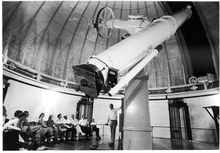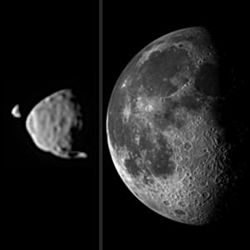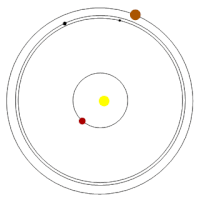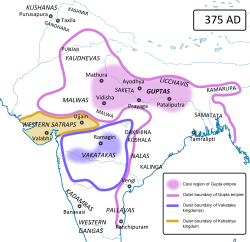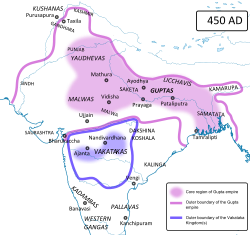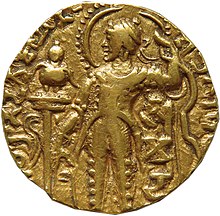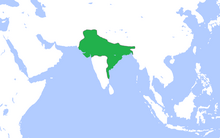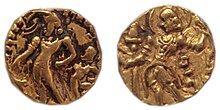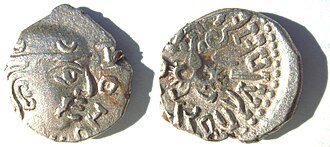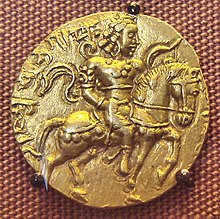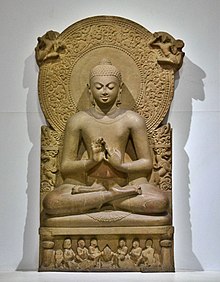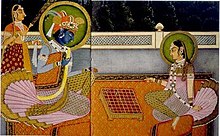The two moons of Mars are Phobos and Deimos. Both were discovered by Asaph Hall in August 1877 and are named after the Greek mythological twin characters Phobos (panic/fear) and Deimos (terror/dread) who accompanied their father Ares into battle. Ares, god of war, was known to the Romans as Mars.
Compared to the Earth's Moon, the moons Phobos and Deimos are small. Phobos has a diameter of 22.2 km (13.8 mi) and a mass of 1.08×1016 kg, while these measures for Deimos are 12.6 km (7.8 mi) and 2.0×1015 kg. Phobos orbits closer to Mars, with a semi-major axis of 9,377 km (5,827 mi) and an orbital period of 7.66 hours; Deimos's semi-major axis is 23,460 km (14,580 mi) with an orbital period of 30.35 hours.
History
Early speculation
Curiosity's view of the Martian moons: Phobos passing in front of Deimos – in real-time (video-gif, 1 August 2013)
Speculation about the existence of the moons of Mars had begun when the moons of Jupiter were discovered. Galileo Galilei,
as a hidden report about him having observed two bumps on the sides of
Saturn (later discovered to be its rings), used the anagram smaismrmilmepoetaleumibunenugttauiras for Altissimum planetam tergeminum observavi ("I have observed the most distant planet to have a triple form"), Johannes Kepler had misinterpreted it to mean Salve umbistineum geminatum Martia proles (Hello, furious twins, sons of Mars).
Perhaps inspired by Kepler (and quoting Kepler's third law of planetary motion), Jonathan Swift's satire Gulliver's Travels (1726) refers to two moons in Part 3, Chapter 3 (the "Voyage to Laputa"),
in which Laputa's astronomers are described as having discovered two
satellites of Mars orbiting at distances of 3 and 5 Martian diameters
with periods of 10 and 21.5 hours. Phobos and Deimos (both found in
1877, more than a century after Swift's novel) have actual orbital
distances of 1.4 and 3.5 Martian diameters, and their respective orbital
periods are 7.66 and 30.35 hours.
In the 20th century, V. G. Perminov, a spacecraft designer of early
Soviet Mars and Venus spacecraft, speculated Swift found and deciphered
records that Martians left on Earth.
However, the view of most astronomers is that Swift was simply
employing a common argument of the time, that as the inner planets Venus
and Mercury had no satellites, Earth had one and Jupiter had four
(known at the time), that Mars by analogy must have two. Furthermore, as
they had not yet been discovered, it was reasoned that they must be
small and close to Mars. This would lead Swift to making a roughly
accurate estimate of their orbital distances and revolution periods. In
addition Swift could have been helped in his calculations by his friend,
the mathematician John Arbuthnot.
Voltaire's 1752 short story "Micromégas", about an alien visitor to Earth, also refers to two moons of Mars. Voltaire was presumably influenced by Swift. In recognition of these 'predictions', two craters on Deimos are named Swift and Voltaire, while on Phobos there is one named regio, Laputa Regio, and one named planitia, Lagado Planitia, both of which are named after places in Gulliver's Travels (the fictional Laputa, a flying island, and Lagado, imaginary capital of the fictional nation Balnibarbi). Many of the craters on Phobos are also named after characters in Gulliver's Travels.
Discovery
Asaph Hall discovered Deimos on 12 August 1877 at about 07:48 UTC and Phobos on 18 August 1877, at the US Naval Observatory in Washington, D.C., at about 09:14 GMT
(contemporary sources, using the pre-1925 astronomical convention that
began the day at noon, give the time of discovery as 11 August 14:40 and
17 August 16:06 Washington mean time respectively).
At the time, he was deliberately searching for Martian moons. Hall had
previously seen what appeared to be a Martian moon on 10 August, but due
to bad weather, he could not definitively identify them until later.
Hall recorded his discovery of Phobos in his notebook as follows:
The telescope used to discover the Martian moons
- "I repeated the examination in the early part of the night of 11th [August 1877], and again found nothing, but trying again some hours later I found a faint object on the following side and a little north of the planet. I had barely time to secure an observation of its position when fog from the River stopped the work. This was at half past two o'clock on the night of the 11th. Cloudy weather intervened for several days.
- "On 15 August the weather looking more promising, I slept at the Observatory. The sky cleared off with a thunderstorm at 11 o'clock and the search was resumed. The atmosphere however was in a very bad condition and Mars was so blazing and unsteady that nothing could be seen of the object, which we now know was at that time so near the planet as to be invisible.
- "On 16 August the object was found again on the following side of the planet, and the observations of that night showed that it was moving with the planet, and if a satellite, was near one of its elongations. Until this time I had said nothing to anyone at the Observatory of my search for a satellite of Mars, but on leaving the observatory after these observations of the 16th, at about three o'clock in the morning, I told my assistant, George Anderson, to whom I had shown the object, that I thought I had discovered a satellite of Mars. I told him also to keep quiet as I did not wish anything said until the matter was beyond doubt. He said nothing, but the thing was too good to keep and I let it out myself. On 17 August between one and two o'clock, while I was reducing my observations, Professor Newcomb came into my room to eat his lunch and I showed him my measures of the faint object near Mars which proved that it was moving with the planet.
- "On 17 August while waiting and watching for the outer moon, the inner one was discovered. The observations of the 17th and 18th put beyond doubt the character of these objects and the discovery was publicly announced by Admiral Rodgers."
The telescope used for the discovery was the 26-inch (66 cm) refractor (telescope with a lens) then located at Foggy Bottom. In 1893 the lens was remounted and put in a new dome, where it remains into the 21st century.
The names, originally spelled Phobus and Deimus, respectively, were suggested by Henry Madan (1838–1901), Science Master of Eton, from Book XV of the Iliad, where Ares summons Fear and Fright.
Mars moon hoax
In 1959, Walter Scott Houston perpetrated a celebrated April Fool's hoax in the April edition of the Great Plains Observer,
claiming that "Dr. Arthur Hayall of the University of the Sierras
reports that the moons of Mars are actually artificial satellites". Both
Dr. Hayall and the University of the Sierras were fictitious. The hoax
gained worldwide attention when Houston's claim was repeated in earnest
by a Soviet scientist, Iosif Shklovsky, who, based on a later-disproven density estimate, suggested Phobos was a hollow metal shell.
Recent surveys
Searches have been conducted for additional satellites. In 2003, Scott S. Sheppard and David C. Jewitt surveyed nearly the entire Hill sphere
of Mars for irregular satellites. However scattered light from Mars
prevented them from searching the inner few arcminutes where the
satellites Phobos and Deimos reside. No new satellites were found to an
apparent limiting red magnitude of 23.5, which corresponds to radii of
about 0.09 km using an albedo of 0.07.
Characteristics
Apparent sizes of the moons of Mars, Deimos and Phobos, and the Moon as viewed from the surface of their respective planets (Mars' moons imaged by the Curiosity rover, 1 August 2013)
If viewed from Mars's surface near its equator, full Phobos looks about one-third as big as a full moon on Earth. It has an angular diameter
of between 8' (rising) and 12' (overhead). Due to its close orbit, it
would look smaller when the observer is further away from the Martian
equator, and is below the horizon and thus invisible when viewed from
Mars's polar ice caps. Deimos looks more like a bright star or planet
for an observer on Mars, only slightly bigger than Venus
looks from Earth; it has an angular diameter of about 2'. The Sun's
angular diameter as seen from Mars, by contrast, is about 21'. Thus
there are no total solar eclipses on Mars, as the moons are far too small to completely cover the Sun. On the other hand, total lunar eclipses of Phobos are very common, happening almost every night.
The motions of Phobos and Deimos would appear very different from
that of Earth's Moon. Speedy Phobos rises in the west, sets in the
east, and rises again in just eleven hours, while Deimos, being only
just outside synchronous orbit,
rises as expected in the east but very slowly. Despite its 30-hour
orbit, it takes 2.7 days to set in the west as it slowly falls behind
the rotation of Mars.
Both moons are tidally locked,
always presenting the same face towards Mars. Since Phobos orbits Mars
faster than the planet itself rotates, tidal forces are slowly but
steadily decreasing its orbital radius. At some point in the future,
when it approaches Mars closely enough, Phobos will be broken up by these tidal forces.
Several strings of craters on the Martian surface, inclined further
from the equator the older they are, suggest that there may have been
other small moons that suffered the fate expected of Phobos, and that
the Martian crust as a whole shifted between these events. Deimos, on the other hand, is far enough away that its orbit is being slowly boosted instead, as in the case of Earth's Moon.
Origin
Animation illustrating the asteroid-belt origin for the moons
The origin of the Martian moons is still controversial. Phobos and Deimos both have much in common with carbonaceous C-type asteroids, with spectra, albedo, and density very similar to those of C- or D-type asteroids. Based on their similarity, one hypothesis is that both moons may be captured main-belt asteroids. Both moons have very circular orbits which lie almost exactly in Mars's equatorial plane, and hence a capture origin requires a mechanism for circularizing
the initially highly eccentric orbit, and adjusting its inclination
into the equatorial plane, most probably by a combination of atmospheric
drag and tidal forces, although it is not clear that sufficient time is available for this to occur for Deimos. Capture also requires dissipation of energy. The current atmosphere of Mars is too thin to capture a Phobos-sized object by atmospheric braking. Geoffrey Landis has pointed out that the capture could have occurred if the original body was a binary asteroid that separated under tidal forces.
Phobos could be a second-generation Solar System object that coalesced in orbit after Mars formed, rather than forming concurrently out of the same birth cloud as Mars.
Another hypothesis is that Mars was once surrounded by many
Phobos- and Deimos-sized bodies, perhaps ejected into orbit around it by
a collision with a large planetesimal. The high porosity of the interior of Phobos (based on the density of 1.88 g/cm3, voids are estimated to comprise 25 to 35 percent of Phobos' volume) is inconsistent with an asteroidal origin. Observations of Phobos in the thermal infrared suggest a composition containing mainly phyllosilicates, which are well known from the surface of Mars. The spectra are distinct from those of all classes of chondrite meteorites, again pointing away from an asteroidal origin. Both sets of findings support an origin of Phobos from material ejected by an impact on Mars that reaccreted in Martian orbit, similar to the prevailing theory for the origin of Earth's moon.
The moons of Mars may have started with a huge collision with a
protoplanet one third the mass of Mars that formed a ring around Mars.
The inner part of the ring formed a large moon. Gravitational
interactions between this moon and the outer ring formed Phobos and
Deimos. Later, the large moon crashed into Mars, but the two small moons
remained in orbit. This theory agrees with the fine-grained surface of
the moons and their high porosity. The outer disk would create
fine-grained material.
Exploration
While many Martian probes provided images and other data about Phobos
and Deimos, only few were dedicated to these satellites and intended to
perform a flyby or landing on the surface.
Two probes under the Soviet Phobos program
were successfully launched in 1988, but neither conducted the intended
jumping landings on Phobos and Deimos due to failures (although Phobos 2 successfully photographed Phobos). The post-Soviet Russian Fobos-Grunt probe was intended to be the first sample return mission from Phobos, but a rocket failure left it stranded in Earth orbit in 2011.
In 1997 and 1998, the Aladdin mission was selected as a finalist in the NASA Discovery Program.
The plan was to visit both Phobos and Deimos, and launch projectiles at
the satellites. The probe would collect the ejecta as it performed a
slow flyby. These samples would be returned to Earth for study three
years later. Ultimately, NASA rejected this proposal in favor of MESSENGER, a probe to Mercury.
In 2007, the European Space Agency and EADS Astrium
proposed and developed a mission to Phobos in 2016 with a lander and
sample return, but this mission was never flown. Since 2007 the Canadian Space Agency has been considering the PRIME mission to Phobos with orbiter and lander. Since 2008 NASA Glenn Research Center began studying a Phobos and Deimos sample return mission. Since 2013 NASA developed the Phobos Surveyor mission concept with an orbiter and a small rover that is proposed to launch sometime after 2023. Proposed NASA's PADME mission proposes to launch in 2020 and reach Mars orbit in 2021 to conduct multiple flybys of the Martian moons. Also, NASA is assessing the OSIRIS-REx II, concept mission for a sample return from Phobos. Another sample return mission from Deimos, called Gulliver. has been conceptualized. Russia plans to repeat Fobos-Grunt mission around 2024.



